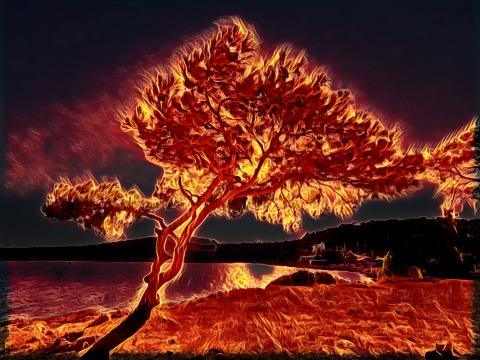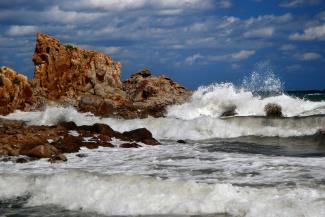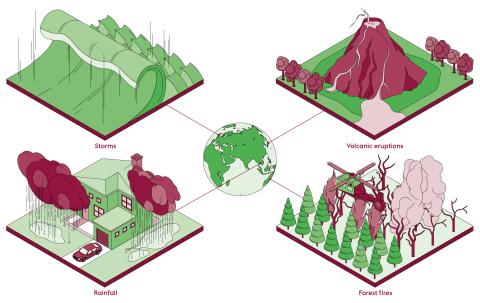
The dynamics of extreme weather Events
This article was originally published in L'Édition N.21.
With extreme weather events expected to become more common as a result of climate change, it is more important than ever to understand and predict their behaviour. To this end, scientists at Université Paris- Saclay are exploring the natural disasters and weather phenomena that occur around the globe, such as forest fires, volcanic eruptions, rainfall and storms. These fluid dynamics specialists have an unparalleled ability to scrutinise the movements of air and water.
Like fires, some of which have been extremely large during recent droughts, volcanic eruptions release huge plumes of smoke that spread through the air. As well as lava, an erupting volcano ejects materials and gases from the Earth’s inner layers. While there are on average around 60 eruptions each year – some occasionally major – of the 1,500 active volcanoes on Earth, the number of drought-related fires is expected to increase with global warming. In addition to the consequences of such events on local fauna, flora and infrastructure, and the risks they pose to populations, the plumes they release also affect the atmosphere and change the climate on a global scale. But in what ways?
Swirling plumes
Sergey Khaykin, researcher at the Atmospheres, Environments, Space Observations Laboratory (LATMOS – Univ. Paris-Saclay, UVSQ, CNRS, Sorbonne Univ.), is tracking the trajectories of the gas, ash and aerosol columns emitted during eruptions to find an answer to this question. “Plumes of smoke are rapidly dissolved in the troposphere, the layer of the atmosphere closest to the ground, as a result of turbulence created by the winds blowing through it.
But in the case of a large fire or a very explosive eruption, the plume reaches the stratosphere, a much calmer layer more than 13 km above the ground,” notes the researcher. This plume can then remain cohesive for months. It is carried by the winds like a hot air balloon, and circles the globe several times.
While some plumes decline over time, others rotate and form cohesive vortices. “This phenomenon was highlighted during the bushfires in Australia in 2020,” explains the LATMOS researcher. “This vortex remained in the stratosphere for more than three months and raised a huge confined bubble of smoke up to 35 km in altitude. Due to the magnitude of the disaster, the vortex was so huge that we could not miss it.” Four conditions must be met for this kind of whirlwind to be created: the plume must reach the stratosphere, have summer weather without strong winds, be warmer than the surrounding air, which drives its initial rotation, and, lastly, be far enough from the equator for the rotational movement to be accentuated by the Coriolis force, an inertial force resulting from the Earth’s revolution on itself and more pronounced near the poles.
Volcanoes become involved
“Once a forest fire reaches a high altitude, it is powerful enough for the other conditions to be met,” says Sergey Khaykin. “However, we thought for a long time that volcano plumes could not display the same behaviour, due to their different composition.” While forest fires release carbonaceous aerosols that heat up under the action of the sun, volcanic plumes are largely composed of sulphate droplets, which absorb little solar radiation.
But recent observations are challenging this paradigm. “We are scrutinising the atmosphere in great detail thanks to the new ground-based instruments and satellites commissioned by the European Space Agency (ESA). In 2019, during an eruption of the Russian volcano Raikoke on the Kuril Islands, we were surprised to observe a very dark plume that retained a consistent shape, gained altitude and rotated on itself. So volcanic eruptions are also capable of creating these longterm vortices if they release a lot of ash.”
Analysing the global consequences
Understanding the dynamics of plumes is essential for predicting their effects. With a narrow vortex, these effects are local and strong: “The giant fires of 2020 weakened the ozone layer and overexposed Australia to UV radiation,” says Sergey Khaykin. Conversely, a diffuse plume tends to have global consequences, such as those caused by the eruption of the underwater volcano Hunga Tonga in January 2022. Located near the Fiji Islands, in the middle of the South Pacific Ocean, this volcano in the Tonga archipelago became the scene of an extremely explosive eruption. The released plume reached a record altitude of 58 km and covered almost the entire globe as it was breaking up. However, no vortex was created as the volcano was too close to the equator and the smoke contained very little ash.
While large volcanic eruptions generally decrease the Earth’s overall temperature by blocking the sun’s rays before they reach the ground, the effect of the Hunga Tonga volcano was quite different. “The seawater vaporised by this underwater eruption increased the concentration of water vapour in the stratosphere by 13%. It was like diverting the course of the Amazon River for ten minutes.” Since water vapour is a greenhouse gas, this extra vapour released into the atmosphere will warm the global climate for at least the next five years before dissipating.
A stormy Irish coast
By chance, while the pressure waves generated by the eruption of the Hunga Tonga volcano were travelling around the world, they were accidentally captured by the research station of the Centre Borelli (Univ. Paris-Saclay, CNRS, ENS Paris-Saclay, Univ. Paris Cité, SSA) on the island of Inis Meáin, off the west coast of Ireland. After capturing this signal, Frédéric Dias’s team shared this curiosity with local school children, “who realised that what happens on the other side of the world can affect them. A parallel with climate change was quickly established,” says the Centre Borelli’s mathematician.
This observation station was built by Frédéric Dias’s team over the last three years and aims to examine another natural phenomenon and its dynamics, namely the breaking of waves. This isolated location, on an island of the Aran archipelago four kilometres long and with a population of around 100, was not selected by chance. “We chose to immerse ourselves in the most extreme conditions, as the west coast of Ireland receives the full force of all the storms that arrive from the Atlantic Ocean. It is perhaps the place in Europe where the waves are the strongest,” says Frederic Dias.
Wave breaking
Among other work, his team is leading the HIGHWAVE project, launched in 2019 and funded by an ERC Advanced Grant from the European Research Council. One of its objectives is to improve wave height forecasts in the open ocean. This wave “weather report” is useful for container ships and ferries, which risk sinking in excessive waves. At the moment, predictions remain inaccurate. “We are years behind in atmospheric meteorology,” says Frédéric Dias.
To improve it, we need to take wave breaking into account in physical models. When a wave becomes too high under the action of the wind, it breaks and creates turbulence, which can be seen in the formation of foam. “While a wave breaks, the system is no longer linear and it becomes extremely difficult to understand its behaviour,” comments Frédéric Dias. However, it is on this task that his team members have started to work, using the various instruments installed in the station. “We brought a seismometer to measure the vibrations caused by waves crashing against the cliffs, a weather station to monitor wind patterns, a high-resolution radar, and sensor-equipped buoys with GPS and accelerometers.” All the equipment is holding up well despite the hostile environment.
The crashing of the waves against the rocks
Before the HIGHWAVE project began, researchers noticed the sheer force of the waves on the island. This is evidenced by the hundreds of tons of stone blocks displaced during winter storms. The team is trying to reproduce these phenomena in the laboratory. “To understand the action and force of the waves, we have previously carried out experiments on a reduced scale,” says Frédéric Dias. The protocol includes a wave generator hitting 8 kg smart blocks filled with sensors, and a high-speed camera. “The pressure is the greatest when the crest and trough of the wave hit the block in the same place.” The key to achieving maximum block displacement is therefore a combination of high pressure and lengthy impact time.
The team is now working on transposing this experiment to the Irish coastal setting. “We instrumented half a dozen one-ton blocks with pressure and acceleration sensors, then observed their movements continuously over several months,” says Frédéric Dias. These observations, which are still underway, will later be combined with numerical computation to model the displacement of the blocks. The HIGHWAVE project research will be developed thanks to an ERC Proof of Concept grant recently received by the researcher for his REALTIMESEA or Real-time measurements of oceanic waves using connected buoys and mobile stations project. The scientists are delighted with the quality of the data already collected and want to continue the station so it can host teams of scientists from all over the world.
Drip erosion
While the power of a raging sea is nothing like the impact of a drop of water, when on the scale of torrential rain, the water also has destructive potential. Researcher Claude Mügler, from the Laboratory for Sciences of Climate and Environment (LSCE – Univ. Paris-Saclay, CNRS, CEA, UVSQ), is interested in the consequences of monsoon rainfall on a watershed in northern Laos, a tropical mountainous region undergoing rapid change. The vegetation on the ground is becoming increasingly scarce as the food crops are being replaced by teak plantations, which are much more lucrative as the teak is then exported. During the rainy season, however, the water intercepted by the very large teak leaves forms huge drops which erode the soil as they fall and prevent the growth of vegetation under the trees. “Soil leaching has become a major concern because it increases erosion and spreads faecal bacteria from livestock manure into the environment,” says Claude Mügler.
On the station, scientists from the French National Research Institute for sustainable Development (IRD), with whom the LSCE researcher collaborates, have set up an experimental mechanism for understanding how raindrops interact with bare soil. On a sloping hillside, artificial rain, whose flow and power are controlled, waters small plots of bare soil measuring one square metre each. A clever process imitates the mechanical action of grass and low vegetation. “Half of each plot is covered with a mosquito net. It is placed a few centimetres above the ground and allows water to pass through, but it breaks the kinetic energy of the water drops, just as plant cover would do,” Claude Mügler explains. There is a real difference between the two half-plots of land. “Without a mosquito net, muddy crusts form under the impact of the raindrops. The environment quickly becomes impermeable. This is the ‘splash’ effect, which amplifies runoff, erosion and the leaching of soil bacteria.”
Finding the equation to describe the runoff
Using data collected in the field by her IRD colleagues, the researcher models the amount of water runoff and the movement of E. coli bacteria contaminating nearby drinking water sources. She constructs equations for flow and transport, with each term corresponding to a physical process, such as the capacity of the soil to allow water to infiltrate. She also takes into account the evolution of soil properties as a function of the time and the thickness of the water runoff.
Finding the right equation to describe the behaviour of the water and the correct values of the parameters requires trial and error. The numerical tools used test a multitude of combinations and only retain those whose results best simulate the field experiments. “I used the Cast3M code, a toolkit that allows us to build small equation blocks and combine them like LEGO® bricks. The parameters are then calibrated, but an expert eye is always needed to ensure the validity of the results,” says the researcher. This multidisciplinary work provides a new understanding of the damage caused by raindrops on bare soil and their health consequences.
All this research sheds new light on the extreme events associated with climate change, and on the deterioration of natural environments and their effects on populations. Like so many new warnings.
Publications
- Khaykin, S.M., et al. Unexpected self-lofting and dynamical confinement of volcanic plumes: the Raikoke 2019 case. Sci Rep 12, 22409 (2022).
- Khaykin, S., et al. Global perturbation of stratospheric water and aerosol burden by Hunga eruption. Commun Earth Environ 3, 316 (2022).
- Steer, J., et al. Breaking-wave induced pressure and acceleration on a clifftop boulder. Journal of Fluid Mechanics 929, R1 (2021).
- Mügler, C., et al. Experimental and modelling evidence of splash effects on manure borne Escherichia coli washoff. Environmental Science and Pollution Research 28, 25 (2021).


